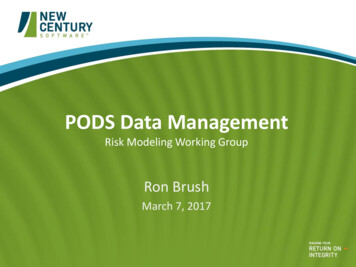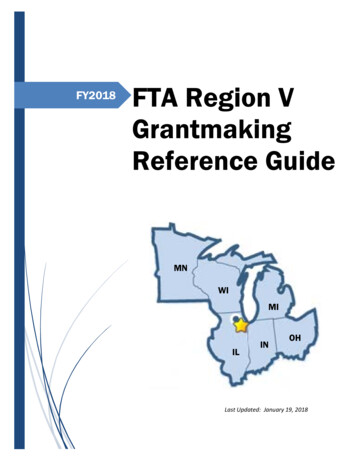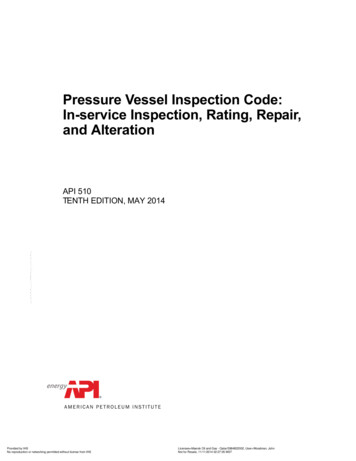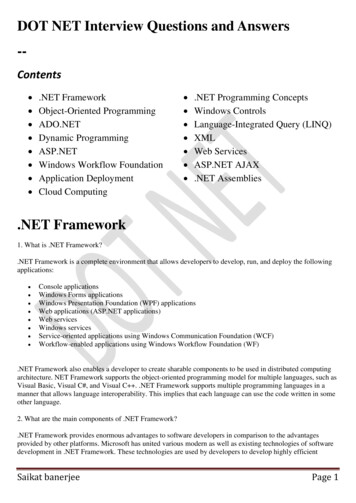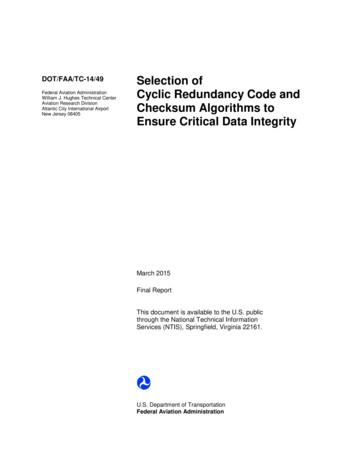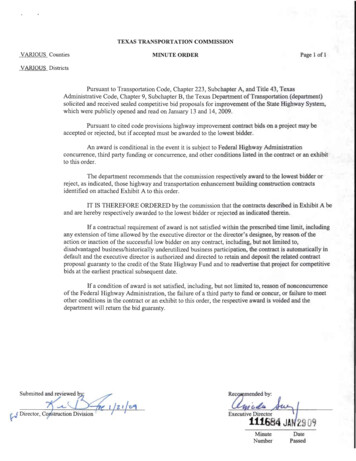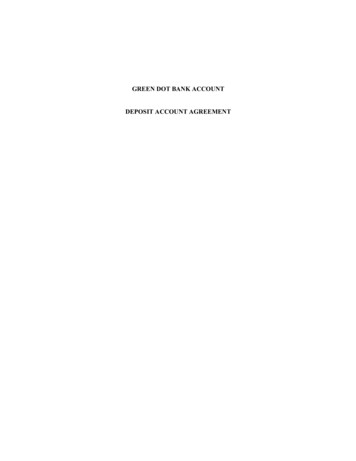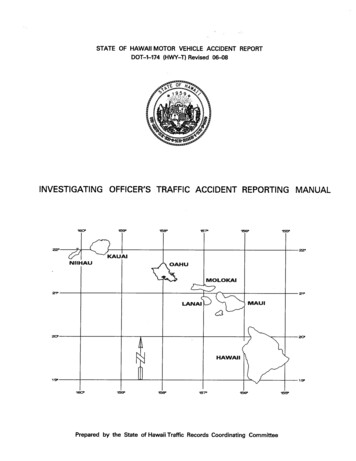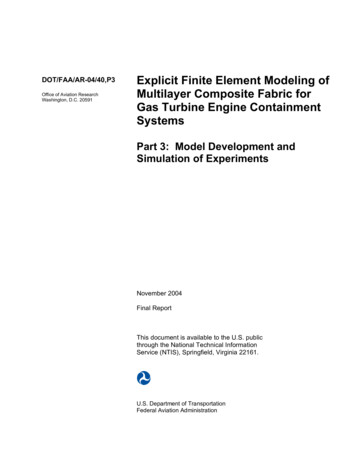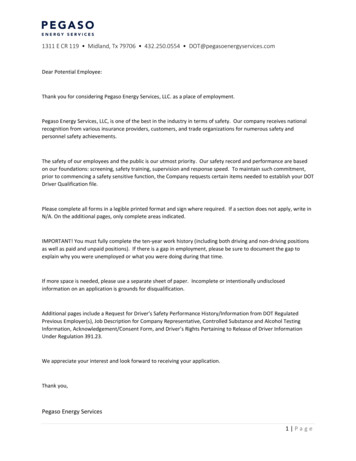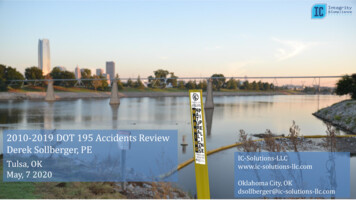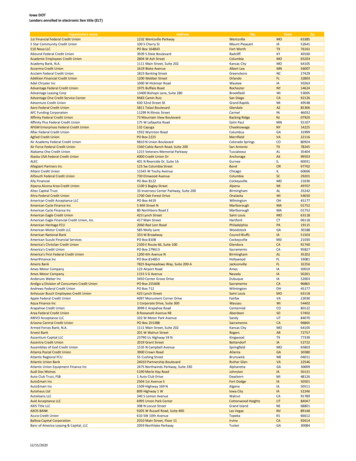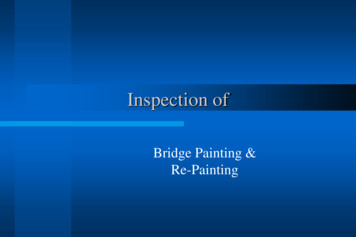
Transcription
Inspection ofBridge Painting &Re-Painting
New Structural Steel Shop Painted– Primary System Inorganic Zinc Primer Polyurethane Top Coat– County Secondary Alkyd Paint SystemPreviousNext
Delivery to the ProjectOverall Condition Damaged Areas Missed Areas Runs and Sags Dry Film Thickness PreviousNext
Overall Condition Look for signs of:– unevenness– Mudcracking– blistering– peeling– soft-to-touch or tackyPreviousNext
Damaged Areas Observe Handling to Minimize Damage– Slings for unloading– Wood or padded blocking for temporarysupport Look for and document any nicks orscratches.– Observe RepairPreviousNext
Missed Areas Look for and Document Any Area Missed– inaccessible areas Observe RepairPreviousNext
Runs and Sags Look for and Document Areas ofExcessive Running or Sagging– Small isolated areas acceptable– Large areas indicate improper application Contact Bridge Construction Engineer if largeareas are encounteredPreviousNext
Dry Film ThicknessThickness of Paint After Cured Shop Inspected Items Are Checked atFabrication Plant Verify Shop Inspection with BridgeConstruction Engineer Items not Shop Inspected Should beInspected on Project PreviousNext
Field Touch-Up & Repair Touch-Up Should be Done After Any Workthat May Further Damage Paint.– Deck Pour– Falsework RemovalPreviousNext
Field Touch-Up & Repair Damaged Areas– Aluminum FilledEpoxy Mastic Primer– Polyurethane Top CoatPreviousNextFaying Surfaces– Polyurethane Top Coat Shop Primed
Field Touch-Up & Repair Touch-Up Paint– Supplied with the Steel– From Same Supplier as Shop Paint– Primer/Top Coat from Same Manufacturer From Approved ListPreviousNext
PreviousNext
PreviousNext
PreviousNext
PreviousNext
Bridge RepaintingSpot Repair vs. Total Repainting Removal of Existing Paint Pre-Surface Preparation Surface Preparation Coating Application Final Inspection PreviousNext
Type of Project Spot Repair––––Girder End ModificationWork Affected AreasDamage RepairRail RetrofitPreviousNextTotal Repainting– Deck Replacement– Paint System Failure– Aesthetics
Removal of Existing Paint Proper Containment of Lead Based PaintResidue is REQUIRED BY LAW.– 220 lbs. Paint Residue may be disposed ofin permitted landfill– 220 lbs. Paint Residue is consideredhazardous material if .05 mg/l leachableleadPreviousNext
Paint Residue Paint Residue is considered to be thecombination of:– Paint Chips– Blasting Media– Any other debris picked up with or added toabove.PreviousNext
Bridge Repainting Classifications Class I– Spot Repair– Power Tool Cleaning (SSPCSP3) Shrouded Vacuum Pickup– Total Repainting– Abrasive Blast Cleaning(SSPC SP6) Complete Removal 15% Blastox by Weight– 220 lbs. ResiduePreviousClass II– 220 lbs. ResidueNext
Containment and Collection “Best Management Practices”required to be used.Containment Plan submitted &approved.Residue stored in sealed 55gallon drums.Drum(s) handled as hazardousuntil tested.Drums stored in securelocation.PreviousNext 55 Gallon Drums must:– be new or meet EPAdefinition of a reusablecontainer.– Must never have previouslycontained petroleumproducts
Containment and CollectionClass I Shrouded Vacuum Power ToolsContractor Must Collect and Weigh Residue– Collect only paint residue– Have Contractor furnish weigh ticketStore in Approved 55 Gallon DrumsDisposal by Department– 220 lbs. - Dispose at permitted landfill– 220 lbs. - Immediately notify Bridge ConstructionEngineer.PreviousNext
Containment and CollectionClass II & III Contractor Must Contain and Collect Residue.Store in Approved 55 Gallon Drums.Representative Sample from 1st 55 Gallon Drum.– Notify Bridge Construction Engineer when sample is attained.– Bridge Construction Engineer will send out “Chain of CustodyRecord.”– Send sample and Chain of Custody record to BridgeConstruction Engineer for testing. Store in Secure Location Until Further Notified.PreviousNext
Responsibility Contractor– Perform work tospecifications.– Be knowledgeable of andcomply with law. OSHA EPAPreviousNextDepartment– Monitor Contractor’s workto assure compliance withspecification/laws– Is owner of any hazardousmaterial.– Disposal of Residue
Pre-Surface Preparation InspectionContractor’s Equipment Paint Materials Abrasive Blasting Media Ambient Conditions PreviousNext
Contractor’s EquipmentContractor Responsible for Selection ofType and Size of Equipment. Inspector Needs to Assure EquipmentProperly Functioning – No Contamination (oil, water, etc.)– Moisture traps– Oil separators– Blotter TestPreviousNext
Blotter Test (ASTM Practice 4285)Shut Off Flow of Abrasive. White Blotter Paper or Other SuitableWhite Absorbent Material 24 Inches fromOutlet Allow Free Air Flow for 2 Minutes Visible Contaminants Require CorrectiveAction. PreviousNext
Paint Materials Approved List orOtherwise Specified.– All components from: Same manufacturer Otherwise specified bymanufacturer (Thinners) Proper ColorPreviousNext Technical Data Sheets Proper Storage Undamaged UnopenedContainers
Abrasive Blasting Media Typically Sand or Coal Slag– Sand not allowed for Class IIIAbrasive should be free of clay and othercontaminants Blastox – Assure Blastox was added in proper amount– Make sure uniformly blended– Certificate of Compliance if pre-blendedPreviousNext
Surface Preparation Inspection Surface Preparation Provides for ProperPaint Adhesion by:– Cleaning Substrate– Providing Surface Roughness Consists Primarily of:– Solvent Cleaning– Power Tool Cleaning– Abrasive Blast CleaningPreviousNext(Anchor Pattern)
Solvent Cleaning (SSPS SP1) Required to Removal All Visible Oil, Grease, andOther Soluble Contaminants.– Coating will not adhere to surface with oil or grease– Abrasive Blasting will drive grease or oil into pores ofsteel. Closely Inspect All Surfaces for VisibleContamination. Notify Contractor of Contaminated Areas.PreviousNext
Power Tool Cleaning (SSPC SP3)Power Assisted Hand Tools Remove All Loose Mill Scale, Loose Rust,Loose Paint, and Other Loose ForeignMaterial – Not intended to remove tightly adherent millscale, rust, or paint. Typically Used for Spot RepairPreviousNext
Abrasive Blast Cleaning Required for Removal of:– Existing Paint– Rust– Mill Scale Required to Attain Proper Anchor PatternPreviousNext
Abrasive Blast Cleaning Compressed Air Cleanliness (Blotter Test) Blasting Pressure Determine Degree of Cleaning Specified– Usually SSPC SP6 - Commercial Blast Cleaning No Visible Contaminants W/O Magnification Minor Discoloration (Staining) on No More Than 33% ofSurface. Use 3 ft. X Full Web Depth Test Sect. and SSPC-VIS 1 (VisualStandard for Abrasive Blast Cleaned Steel)PreviousNext
Use of SSPC-VIS 1 (Visual Standard forAbrasive Blast Cleaned Steel) Determine Initial Grade of Rust Prior to SurfacePreparation. Determine Specified Degree of Cleaning From Table-1, Determine Which Visual Standardto Use.Note: Visual Std’s. are only a guide. Specifieddegree of cleaning governs.PreviousNext
Anchor Pattern (Surface Profile) Specifications Require 1to 3 mils– If max. surface profile of 3mils cannot be maintained,Increase coating thicknessaccordingly. Surface ComparatorTestex TapePreviousNext To Achieve AnchorPattern, Contractor MayNeed to Change:– Abrasive Size– Abrasive Type– Blasting Pressure
Surface Comparator Placed on prepared surface5X to 10X MagnificationAnchor profile is determined,based on a comparisonbetween comparator &surface,PreviousNext
Testex Tape (Film) Equipment:– Micrometer– Testex Tape (Film) 0 to 2 mils (Coarse) 1.5 to 4.5 mils X-Coarse– Burnishing ToolPreviousNext
Testex Tape PROCEDUREClean/CalibrateMicrometer to ZeroPrepare Tape – Remove Backing– Inspect for damage Measure Thickness– Pre-measured thickness ismax. profile height tapeshould be used for.PreviousNextPlace Tape on Steel &Rub With Burnishing ToolMeasure Tape ThicknessProfile Reading - 2 mils– If Profile is close to orexceeds pre-measuredvalue, retest with differenttape.
Inspection of Coating ApplicationTime Restraints Ambient Conditions Mixing & Thinning Paint Application Methods Coating Thickness PreviousNext
Time Restraints Steel Must be Primed Within 24 Hours ofSurface Preparation. Follow Manufacturer’s Recommendations FromProduct Data Sheet for:– Induction Time (Time between mixing and appl.)– Pot Life– Cure Time Between CoatsPreviousNext
Ambient Conditions Specification Requirements– Manufacturer’s Recommendation or StandardSpecifications, Whichever is More Stringent. Temp. of Paint, Steel, & Air– Between 40 F and 90 FSteel Temp. 5 F Above Dew Point Relative Humidity 85% PreviousNext
Temperature Coating Materials Should be Stored toAttain Proper Temp. Steel Temperature– Magnetic Surface Thermometer– At Exact Location of painting– Not in Direct SunlightPreviousNext
Psychrometer Measures:– Ambient Air Temp.– Relative Humidity– Dew PointInstructions Saturate cotton with waterStringFasten twothermometers togetherw/ rubber bands Swing apparatus several times Record temperature Repeat until no change in readings Use Table or Graph for Rel. Humidity & Dew Point Ambient Air Temp. Dry Bulb Therm. ReadingPreviousNextCotton held w/ rubberband
Mixing Paint Proper Mixing Is Important To AssureConsistency Mixing in accordance with Tech. Data Sheet Paint Consists Of:– Vehicle– Solids Vehicle and Solids Must Be Thoroughly MixedPreviousNext
Thinning Thin Paint Materials:– Only when absolutely necessary– In accordance with manufacturer’s technicaldata sheet– Only with the proper thinners(Wrong Thinner or Too Much Thinner isDetrimental to Coating)PreviousNext
Paint Application Stripe Coating– Edges, Corners, Bolt Heads, Nuts, Etc. Shallbe coated prior to application of primer andtop coats.– Typically done by brush Roller or Mitts may be allowed, but coatingthickness should be closely monitored. Spray application of stripe coat is not allowed.PreviousNext
Application MethodsConventional Spray Airless Spray Brushes Rollers Mitts PreviousNext
Conventional / Airless SprayContractor Responsible for EquipmentSetup / Adjustments Inspector Should be Concerned withPainter’s Technique for Application – Proper Overlap– Sectioning– Triggering– Inside/Outside CornersPreviousNext
Spray Technique Overlap previous pass by approx. 50%Large areas should be broken down such that 18 to 38inch strokes are usedSpray gun turned off at end of stroke and not turnedback on until gun is moving in opposite directionInside/Outside Corners– Each Face Separately on Inside Corners– Spray Gun Faced Directly at Corner for Outside Corners, theneach surface.PreviousNext
Spray Technique Proper Spray Technique Should Result in:– Proper Thickness– No Runs or Sags– No Dry Spray– No Holidays Visual Inspection & Wet/Dry FilmThickness Will Confirm CompliancePreviousNext
Feathering and Spot Painting Junction Between Sound Existing Coating andSpot Cleaned Areas Should Present a Smooth,Feathered Appearance.– Sand Around Spot Repair (Feather Edging)– Overlap Existing Coating– Note Any Effect New Coating May Have on ExistingCoating (Stop! and Notify Bridge Constr. Engr.) Bubbling Wrinkling LiftingPreviousNext
Coating Thickness Wet Film Thickness (WFT)– Used only as a guide as to what final dry filmthickness will be achieved. Dry Film Thickness (DFT)– Governed by specifications and used foracceptance.PreviousNext
Wet Film Thickness Estimate of DFTW D[1.0 T]SWhere:W WFT is in milsD DFT is in milsS % Solids by VolumeT % Volume of ThinneraddedPreviousNext
Dry Film Thickness 5 Spot MeasurementsEvery 100 Sq. Ft.– Each spot measurementconsists of an average of 3gage readings Acceptable Results– Average of 5 spotmeasurements withinspecified limits for DFT– No spot measurement lessthan 80% of min. specifiedPreviousNext
Visual InspectionSame as Previously Discussed for NewStructures:PreviousNext
Use of SSPC-VIS 1 (Visual Standard for Abrasive Blast Cleaned Steel) Determine Initial Grade of Rust Prior to Surface Preparation. Determine Specified Degree of Cleaning From Table-1, Determine Which Visual Standard to Use. Note: Visual Std’s. are only a guide. Specified degree of cleaning governs.
